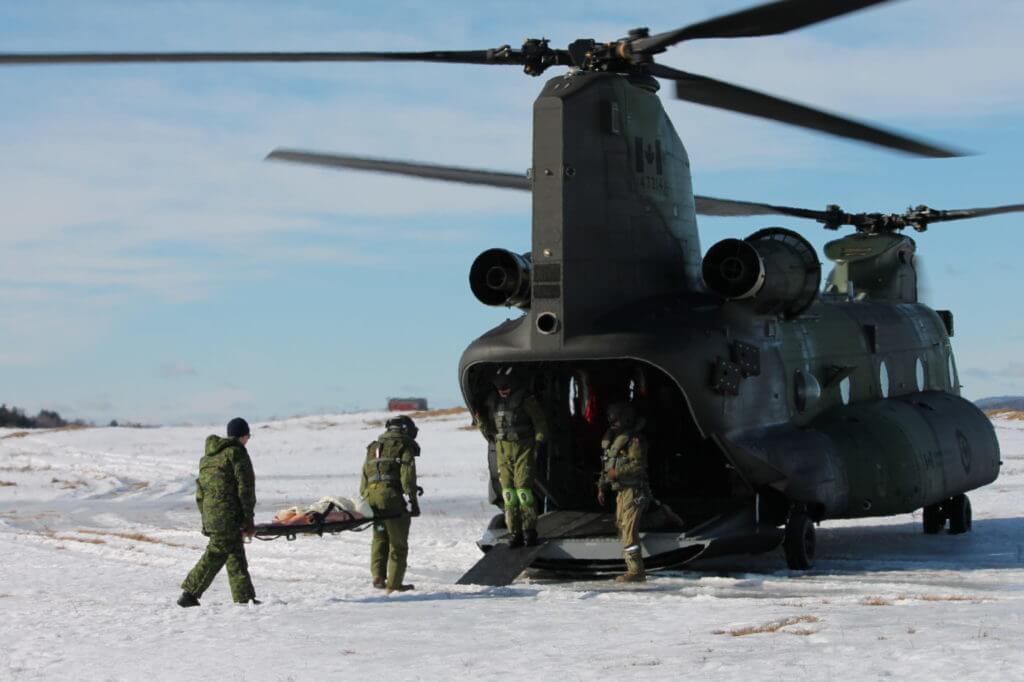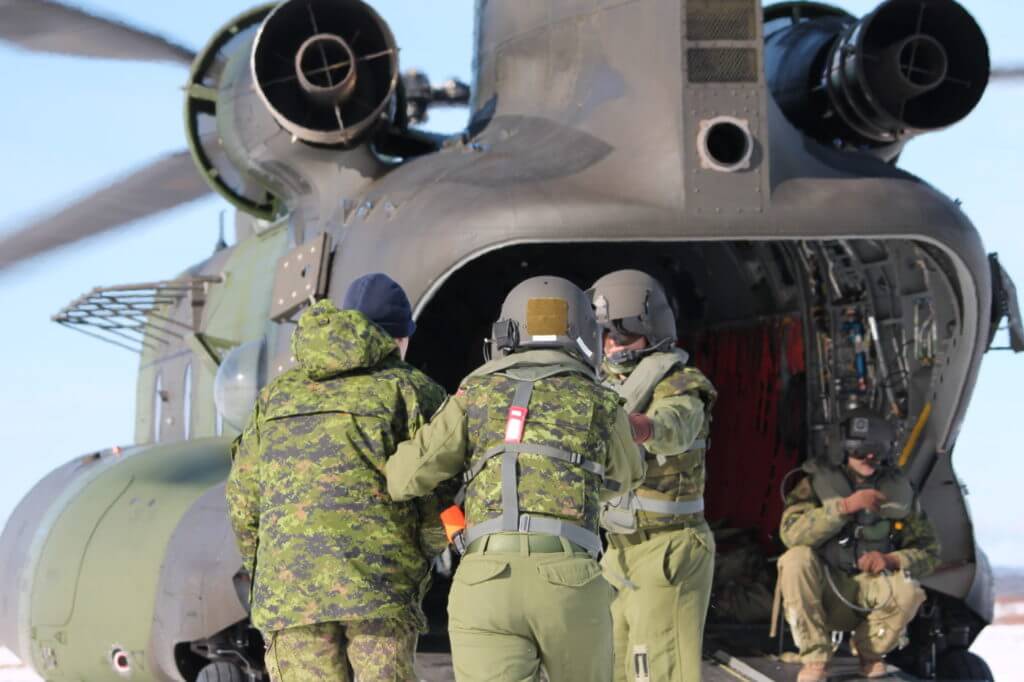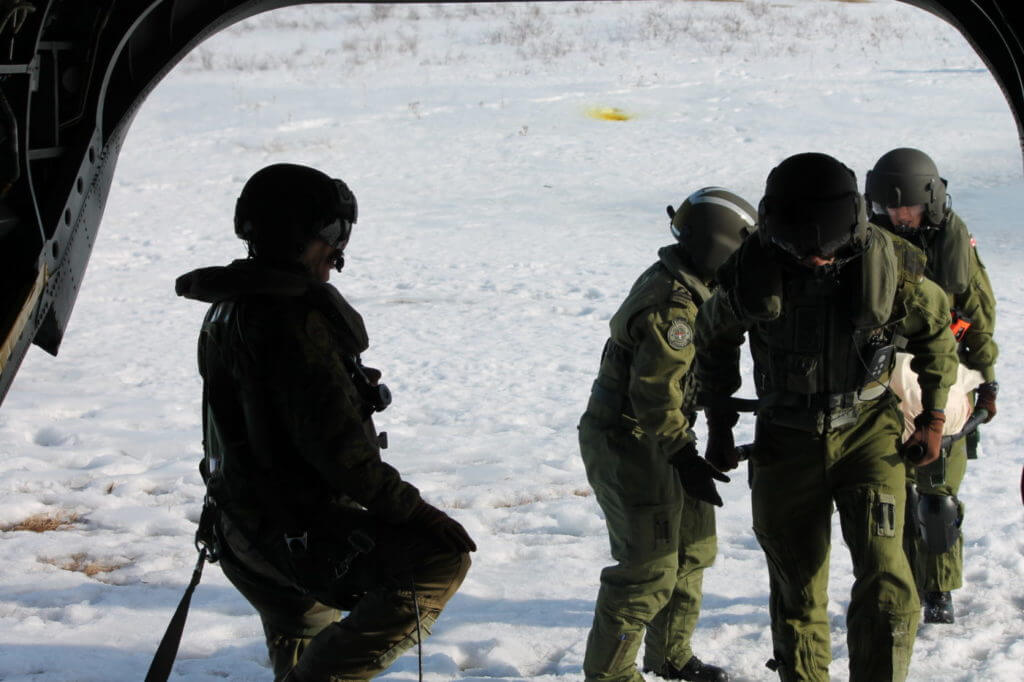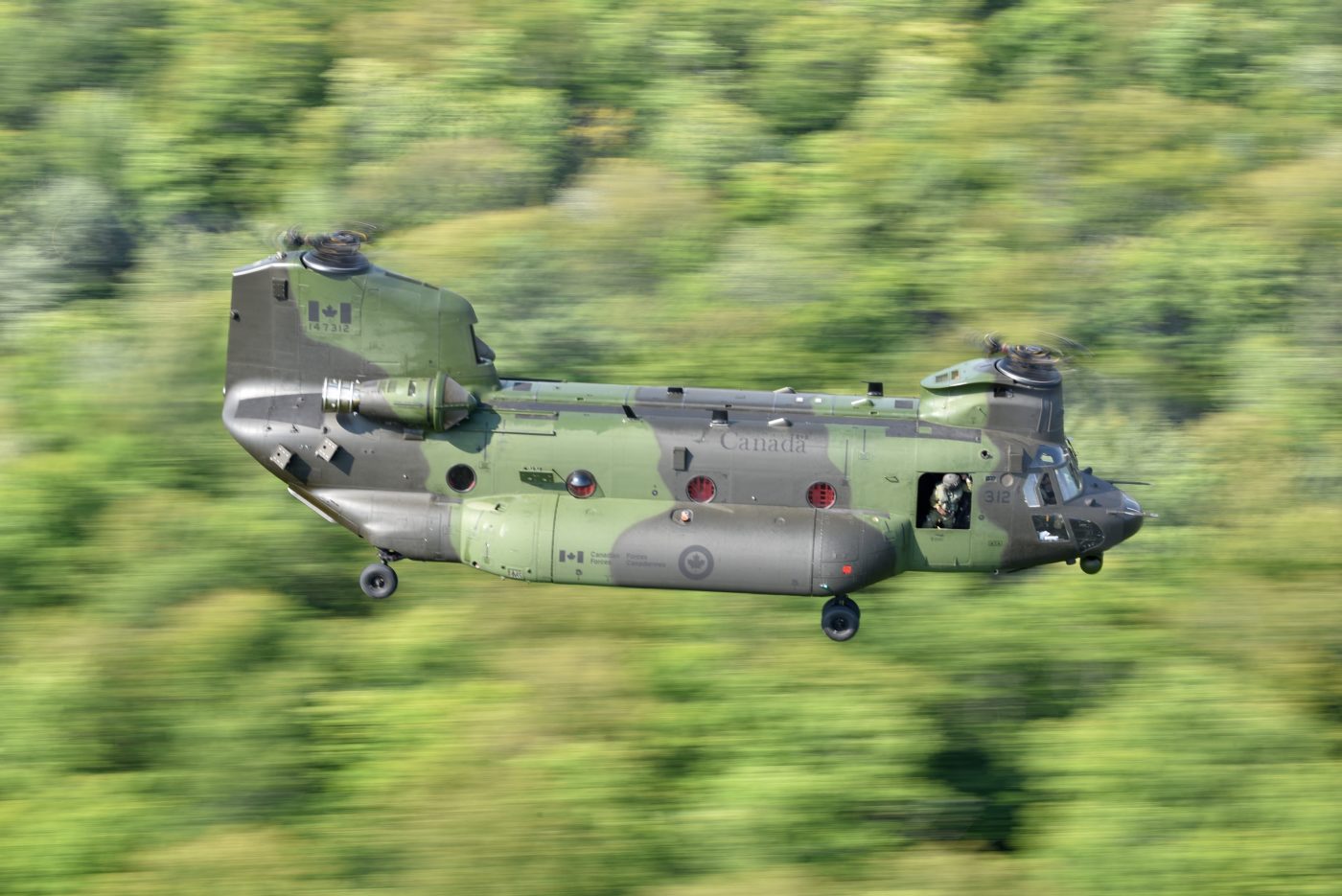Before Canada deploys an aviation task force to Mali this summer, helicopter aircrews, Canadian Forces Health Services personnel and force protection teams from the Canadian Army are validating a new capability with the CH-147F Chinook. The goal is to push advanced medical teams as far forward as possible in a combat zone to provide early intervention and medical care to injured personnel.
In exercises in Petawawa, Ontario, and Wainwright, Alberta, this spring, Chinook pilots, loadmasters and flight engineers, together with medical teams and soldiers, trialed and then began training to deliver what is known as forward aeromedical evacuation, treating and then airlifting injured soldiers directly from the battlefield.

The Canadian Armed Forces (CAF) has had strategic air medical evacuation with fixed-wing aircraft for decades, most recently transporting patients from Germany back to Canadian medical facilities during the Afghanistan conflict. But it has traditionally relied on allies and coalition partners for casualty evacuation in war zones.
In July 2017, following the release of the government’s defense policy, Gen Jonathan Vance, Chief of the Defence Staff, issued a directive to develop an integral forward aeromedical evacuation capability, ready for deployment by August 2018.
Casualty evacuation was always one of several capabilities to be developed when the Royal Canadian Air Force first took possession of a new fleet of 15 Boeing-built Chinook helicopters in 2015. But the likelihood of a peacekeeping mission undoubtedly kickstarted the process, even though the commitment of tactical transport and logistic support to a United Nations mission was not announced until November 2017, and confirmation of two Chinook transport and four CH-146 Griffon escort helicopters to the dangerous mission in Mali came in March 2018.
“I knew it was something we could do and would be valuable to have in our tool box,” said LCol Darryl Adams, commander of 450 Tactical Helicopter Squadron in Petawawa and a former Griffon pilot with experience in Afghanistan who observed the Royal Air Force capability firsthand.
“Helicopters are always in high demand, and the ability to evacuate soldiers that have serious injuries quickly, to get them to a medical facility and save lives, is always going to be an in-demand capability. So this is just the continued evolution of the Chinook.”
A basic forward air medical evacuation program was developed in 2007 for the Griffon platform when an air task force was deployed to Afghanistan to support Canadian and coalition operations, but the Health Services-led initiative “wasn’t suitable for a sustained deployment,” said LCol Richard Hannah, 1st Canadian Division Flight Surgeon, noting that allies often had helicopters better suited for the role.

As part of his 2017 directive, Vance placed responsibility for the capability development in the hands of the Air Force, with support from Health Services.
“It’s a team event,” said Hannah, adding that it will leverage the skill set of personnel already well trained in fixed-wing aeromedical evacuation. “Our goal is really to do advanced resuscitation right from the point of injury to the first level of care.”
Gathering best practices
Before determining the training required for the specialized teams, the RCAF sent aircrews and medical professionals to look at how allies, especially the United Kingdom in Afghanistan and the Netherlands in Mali, were conducting forward air evacuation with their Chinooks. Gathering best practices helped shape collective training as well as identifying possible equipment changes.
The medical teams will comprise emergency medical and critical care physicians, anesthesia and intensive care unit doctors with “lots of experience in places like Afghanistan or Iraq, or [with] civilian-related experiences in a pre-hospital environment,” said Hannah. “We are using those people as our clinical leads, and then supplementing them with our critical care nursing and medical technician capability.”
The objective, he explained, is a scalable capability that can be ramped up from a single med tech, essentially a paramedic, to a critical care team of physicians, nurses and techs. “All those people are aircrew,” he added. “They are all air medical evacuation specialists that fall under all the same rules as the pilots, loadmasters and flight engineers.”
While the forward air evac capability does not require substantial new training for the Chinook aircrews, there are some nuances to working with medical techs or physicians trying to perform life-saving procedures in the back, Adams acknowledged.

The first phase of collective training began in March and involved familiarizing the medical personnel with the aircraft, including basic safety and crash procedures, day and night flying, and the experience of working in a shuddering cabin at 140 knots. The team then progressed to scenarios such as airborne re-tasking, where the crew is asked to re-role from one assignment to another mid-flight, and coordinate with ground and other sources to understand the conditions they are flying into and the nature of the injuries they’ll need to treat.
Whether a crew is on standby or re-roled while en route somewhere else, “having that initial jolt to action” is a key moment, Adams explained, as teams struggle to gather information that is often “nebulous or incorrect [at first] and try to build a picture of what’s happening on the ground, what kind of a threat [they’ll] face, and so on.”
In addition to identifying some common operating procedures, the two weeks of training also pinpointed the need for wireless communications equipment to allow better movement for medical personnel without tripping over the loadmaster’s headset cord, and for better communications gear to connect with the infantry force protection team while on the ground.
“We are reusing some equipment we already had in our possession,” Adams explained, “but we had to go out and buy certain equipment that would not disturb the communications devices in the aircraft, for example, the navigation system.”
That was also a concern with medical equipment. While Hannah did not anticipate any problems, he said one consideration for any new or novel device would be rapid testing to “make sure it is airworthy on a Chinook helicopter” and does not interfere with the aircraft’s electronic systems.
The initial trials also underscored the importance of a communication protocol between the medical professionals and aircrew. While the doctors, nurses and med techs do not want to interfere with how the pilots fly the aircraft, there may be times when they need to alert the aircrew “not to put us into some extreme angle … because we are doing something sensitive at the moment,” said Hannah.

“Being able to communicate back and forth in a way that is effective and purposeful is really important. We have some systems we’ve trialed. They work well in a fixed-wing environment. We are basically going to use the same model, so we don’t have six people trying to tell the pilot what to do. The key is to make sure you have one point of contact between the medical team and the front-end team.”
Adams noted that the severity of the injuries and the need to reach a medical facility would dictate whether “it is low and slow or as fast as we can.”
That decision might also be affected by whether armed escort provided by the Griffon helicopters is required. “If we have to go max speed, then the Griffon might not be able to keep up with us. That’s an assessment for the crew,” he said.
To bolster the number of medical assets in a life-threatening situation, the Army’s force protection team might also beef up its medical training. Infantry soldiers have tactical combat casualty care, an advanced level of first aid, but might receive additional training if it’s deemed necessary.
Aircrew, medical crew, and force protection need to be integrated “into one unified team, where we can help one another out,” said Hannah.
Adams noted that the force protection personnel will already be highly skilled soldiers “who can make some very good decisions quickly” to secure landing zones and work with the more than 50 different nations participating in the UN Multidimensional Integrated Stabilization Mission in Mali (MINUSMA).
Exactly how many medical teams will be required in Mali remains to be determined. But when Adams and Hannah spoke with Vertical, two teams were prepared and a third was beginning its individual training. And the concept and personnel were expected to be validated at an exercise in Wainwright, Alberta, in May.

“We have been working on this for a long time and I’m glad to see it going out the door,” said Hannah. “It’s a great opportunity to use a fantastic aircraft to do some really good work and support the UN, and develop this capability, not just for Mali, but as an enduring capability … that we haven’t really had in the past.”





